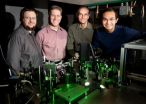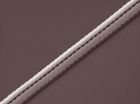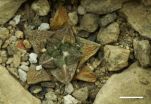(Press-News.org) CHAMPAIGN, Ill. – The long, anxious wait for biopsy results could soon be over, thanks to a tissue-imaging technique developed at the University of Illinois.
The research team demonstrated the novel microscopy technique, called nonlinear interferometric vibrational imaging (NIVI), on rat breast-cancer cells and tissues. It produced easy-to-read, color-coded images of tissue, outlining clear tumor boundaries, with more than 99 percent confidence – in less than five minutes.
Led by professor and physician Stephen A. Boppart, who holds appointments in electrical and computer engineering, bioengineering and medicine, the Illinois researchers will publish their findings on the cover of the Dec. 1 issue of the journal Cancer Research.
In addition to taking a day or more for results, current diagnostic methods are subjective, based on visual interpretations of cell shape and structure. A small sample of suspect tissue is taken from a patient, and a stain is added to make certain features of the cells easier to see. A pathologist looks at the sample under a microscope to see if the cells look unusual, often consulting other pathologists to confirm a diagnosis.
"The diagnosis is made based on very subjective interpretation – how the cells are laid out, the structure, the morphology," said Boppart, who is also affiliated with the university's Beckman Institute for Advanced Science and Technology. "This is what we call the gold standard for diagnosis. We want to make the process of medical diagnostics more quantitative and more rapid."
Rather than focus on cell and tissue structure, NIVI assesses and constructs images based on molecular composition. Normal cells have high concentrations of lipids, but cancerous cells produce more protein. By identifying cells with abnormally high protein concentrations, the researchers could accurately differentiate between tumors and healthy tissue – without waiting for stain to set in.
Each type of molecule has a unique vibrational state of energy in its bonds. When the resonance of that vibration is enhanced, it can produce a signal that can be used to identify cells with high concentrations of that molecule. NIVI uses two beams of light to excite molecules in a tissue sample.
"The analogy is like pushing someone on a swing. If you push at the right time point, the person on the swing will go higher and higher. If you don't push at the right point in the swing, the person stops," Boppart said. "If we use the right optical frequencies to excite these vibrational states, we can enhance the resonance and the signal."
One of NIVI's two beams of light acts as a reference, so that combining that beam with the signal produced by the excited sample cancels out background noise and isolates the molecular signal. Statistical analysis of the resulting spectrum produces a color-coded image at each point in the tissue: blue for normal cells, red for cancer.
Another advantage of the NIVI technique is more exact mapping of tumor boundaries, a murky area for many pathologists. The margin of uncertainty in visual diagnosis can be a wide area of tissue as pathologists struggle to discern where a tumor ends and normal tissue begins. The red-blue color coding shows an uncertain boundary zone of about 100 microns – merely a cell or two.
"Sometimes it's very hard to tell visually whether a cell is normal or abnormal," Boppart said. "But molecularly, there are fairly clear signatures."
The researchers are working to improve and broaden the application of their technique. By tuning the frequency of the laser beams, they could test for other types of molecules. They are working to make it faster, for real-time imaging, and exploring new laser sources to make NIVI more compact or even portable. They also are developing new light delivery systems, such as catheters, probes or needles that can test tissue without removing samples.
"As we get better spectral resolution and broader spectral range, we can have more flexibility in identifying different molecules," Boppart said. "Once you get to that point, we think it will have many different applications for cancer diagnostics, for optical biopsies and other types of diagnostics."
INFORMATION:
The National Cancer Institute of the National Institutes of Health sponsored the study. Other co-authors were Beckman Institute researchers Praveen Chowdary, Zhi Jiang, Eric Chaney, Wladimir Benalcazar and Daniel Marks, and professor of chemistry and physics Martin Gruebele.
Editor's note: To reach Stephen Boppart, call 217-244-7479; e-mail boppart@illinois.edu. The paper, "Molecular Histopathology by Spectrally Reconstructed Nonlinear Interferometric Vibrational Imaging," is available online at http://cancerres.aacrjournals.org/content/early/2010/11/19/0008-5472.CAN-10-1554.abstract.
New imaging technique accurately finds cancer cells, fast
2010-11-25
ELSE PRESS RELEASES FROM THIS DATE:
Massive galaxies formed when universe was young
2010-11-25
MEDFORD/SOMERVILLE, Mass. -- Some of the universe's most massive galaxies may have formed billions of years earlier than current scientific models predict, according to surprising new research led by Tufts University. The findings appear in the Astrophysical Journal published online Nov. 24 in advance of print publication on Dec. 10, 2010.
"We have found a relatively large number of very massive, highly luminous galaxies that existed almost 12 billion years ago when the universe was still very young, about 1.5 billion years old. These results appear to disagree with ...
Early intervention essential to success for at-risk children: Queen's University study
2010-11-25
Children living in disadvantaged neighbourhoods are more likely to succeed if they participate in a community-based prevention program, according to findings released recently from a multi-year research study based at Queen's University.
Children participating in the Better Beginnings, Better Futures (BBBF) project showed improved social and academic functioning. The project also impacted positively on families and on neighbourhoods.
"The results from our study indicate that the project has been a success," says Queen's psychology professor emeritus Ray Peters, the ...
Short, on-chip light pulses will enable ultrafast data transfer within computers
2010-11-25
Electrical engineers generated short, powerful light pulses on a chip – an important step toward the optical interconnects that will likely replace the copper wires that carry information between chips within today's computers. University of California, San Diego electrical engineers recently developed the first ultra compact, low power pulse compressor on a silicon chip to be described in the scientific literature. Details appeared online in the journal Nature Communications on November 16.
This miniaturized short pulse generator eliminates a roadblock on the way to ...
Quartz crystal microbalances enable new microscale analytic technique
2010-11-25
A new chemical analysis technique developed by a research group at the National Institute of Standards and Technology (NIST) uses the shifting ultrasonic pitch of a small quartz crystal to test the purity of only a few micrograms of material. Since it works with samples close to a thousand times smaller than comparable commercial instruments, the new technique should be an important addition to the growing arsenal of measurement tools for nanotechnology, according to the NIST team.
As the objects of scientific research have gotten smaller and smaller—as in nanotechnology ...
New guidance issued for first responders collecting suspected biothreat agents
2010-11-25
Suspicious packages and powders have triggered more than 30,000 responses by U.S. law enforcement agencies across the country since 2001. These events are expensive, time-consuming and potentially dangerous. To help first responders at all levels of government deal safely and more effectively with suspected biothreat agents, the National Institute of Standards and Technology (NIST) and a broad team of federal, state and local agencies and other organizations worked together to update an existing standard for sample collection and develop overall guidance for when to collect ...
Cholera and vaccine experts urge United States to stockpile vaccine
2010-11-25
As the cholera epidemic in Haiti continues to rage, public health workers are focusing their efforts on treating the tens of thousands who have already been hospitalized with cholera-like symptoms and providing clean water and adequate sanitation to control the disease's spread.
Could the United States be doing more to help the situation? In an editorial published in the November 24, 2010, issue of the New England Journal of Medicine, vaccine and infectious disease specialists Matthew Waldor of the Howard Hughes Medical Institute, Peter Hotez of George Washington University ...
Can cacti 'escape' underground in high temperatures?
2010-11-25
In the scorching summer heat of the Chihuahuan Desert in southwest Texas, air temperatures can hover around 97°F (36°C) while at the surface of the soil temperatures can exceed 158°F (70°C). Encountering these extreme temperatures, plants must utilize creative methods to not only survive but thrive under these difficult and potentially lethal conditions.
This new work by Dr. Gretchen North and colleagues, published in the December issue of American Journal of Botany (http://www.amjbot.org/cgi/reprint/ajb.1000286v1), sheds light on how one desert resident, the cactus ...
Finger-trap tension stabilizes cells' chromosome-separating machinery
2010-11-25
Scientists have discovered an amazingly simple way that cells stabilize their machinery for forcing apart chromosomes. Their findings are reported Nov. 25 in Nature.
When a cell gets ready to split into new cells, this stable set-up permits its genetic material to be separated and distributed accurately. Otherwise, problem cells – like cancer cells— arise.
The human body contains more than a trillion cells, and every single cell needs to have the exact same set of chromosomes. Mistakes in moving chromosomes during cell division can lead to babies being born with ...
Merrill Corporation Provides Lextranet Certification
2010-11-25
Merrill Corporation (www.merrillcorp.com), a leading global provider of technology-enabled services, today announced its Lextranet Certification Program for contract attorney reviewers. Lextranet is a single, secure and scalable online review and hosting platform that provides on-demand access for easy review of small or large document collections. The program will enhance Merrill's integrated hosting and review offering by ensuring that reviewers have the knowledge and skills necessary to maximize the features built into Lextranet.
"As a result of the training, document ...
Food Truck Marketing: The Brainchild Group Goes Mobile, Literally
2010-11-25
The Brainchild Group, a collection of marketing professionals and foodies, is excited to announce the launch of Search Engine Optimization (SEO) and Social Media Marketing campaigns for food trucks around the world. You asked for it, and it's finally here.
The Brainchild Group is best known for implementing revolutionary, catchy online marketing campaigns for a variety of businesses ranging from mom-and-pop shops to top restaurants to Fortune 500 companies. Such expertise is combined with a true passion for food to produce marketing campaigns that connect and interact ...




